After an occultation of Rho Leonis by the Moon, watch Venus and Uranus pair up in a weekend conjunction just 10° from Comet PanSTARRS (C/2015 ER61).
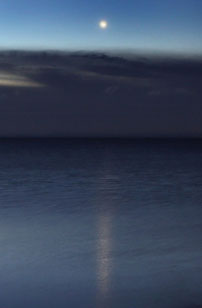
Bob King
The alarm went off at 3:30 a.m. Checking to see if the sky was clear, I thought I saw thick fog illuminated by a neighbor's yard lights and nearly returned to bed. But after rubbing my eyes and looking a second time, I realized the glow was dawn and the sky cloudless. Will I ever get used to how crazy early summer twilight begins?
Dawn brings many good things this season including the reassuring sight of Venus every single clear morning. It currently rises in eastern Pisces around 3:45 a.m. local time and stands some 13° high an hour before sunrise from the central United States. Through a small telescope the planet appears 48% illuminated but will expand to a neat 50% on June 3, when it reaches greatest western elongation from the Sun.
By happy coincidence, that's also the day Venus will be in close conjunction with its distant sibling Uranus. Neither planet is in a particular hurry, so they linger together for several mornings, coming closest on the 3rd, when they're just 1° 42′ apart. If you've never seen a conjunction between these two, it makes a wonderful study in opposites. With a surface temperature of 864°F (462°C), Venus is the consistently hottest planet in the Solar System. Uranus, on the other hand, is the coldest.
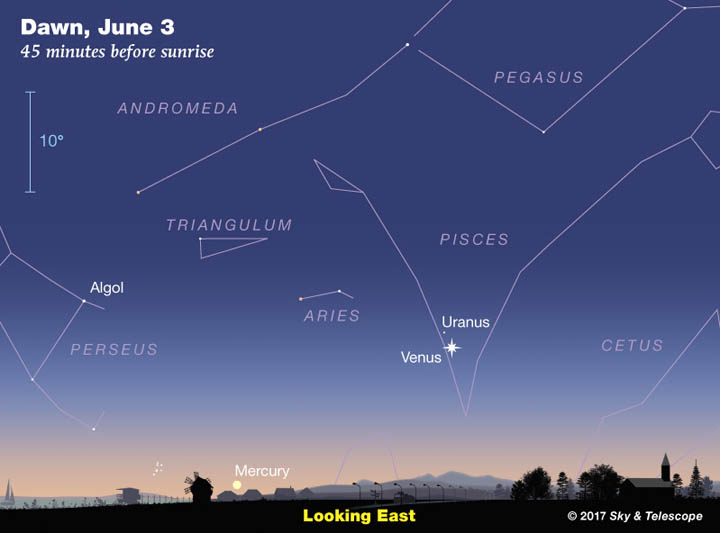
Sky & Telescope
What? Colder than more distant Neptune? Yes, because Uranus's core gives off less heat than the cores of the other giant planets, so its cloud tops register a colder temperature. Try –357°F (–216°C), about four degrees chillier than Neptune. There's a certain poetry, then, in the June 3rd tête-à-tête of warmest and coldest, a pairing of planets so dissimilar they somehow complement one another. Opposites really do attract.
The diagram above shows the view 45 minutes before sunrise, but given that Uranus will magnitude +5.9, it wouldn't hurt to start earlier, say an hour and a quarter before sunrise, to take advantage of a darker sky. This is especially true if you live in the northern U.S., where dawn begins early! A pair of 35-mm or 50-mm binoculars magnifying 7–10× should be all you need to pick out pinpoint Uranus slightly above Venus in the same field of view.
You'll see a brighter 4th-magnitude star just to left of Venus with the delightful name of Tocularis Septentrionalis (a.k.a. Omicron Piscium). It roughly translates to "Northern Thread," an old Arabic reference to the flaxen threads or cord tying the fish together at either end of the constellation. The name rat-a-tats off the tongue like one of my other favorite stars, Zubenelgenubi.
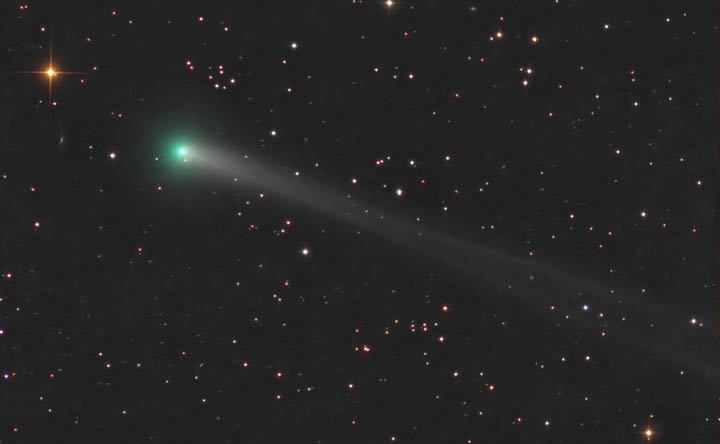
Damian Peach
If bad weather interferes on the day of conjunction, don't worry: Venus and Uranus will remain within 2.5° of each other from June 1–4. Use the panel maps below to help you know just where to look. The maps also plot the position of Comet PanSTARRS (C/2015 ER61), which has been hanging around Venus low in the eastern pre-dawn sky for some time now. Extinction from low altitude may preclude you seeing the 8th-magnitude object in binoculars, but a 6-inch scope should show it easily.
For the best views of the comet, start your morning observing session 90 minutes to 2 hours before sunrise, when the sky is still dark.
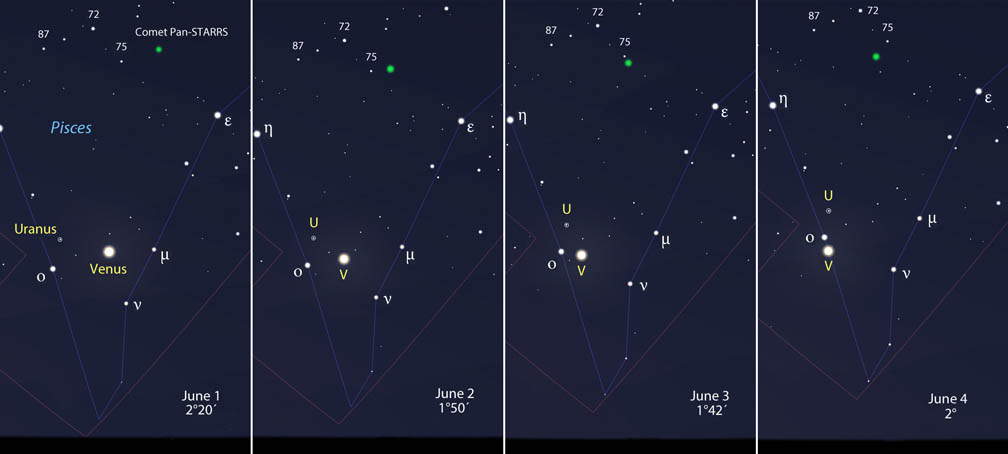
Map: Bob King; Source: Stellarium
That's not all. Die-hards can try digging up Mercury from the horizon haze starting about 45 minutes before sunrise. Look for it with binoculars two and half fists (26°) to the lower left of Venus. At magnitude +0.4, it's relatively bright, but it stands only about 3–4° high.
Rho, Rho, Rho Your Scope
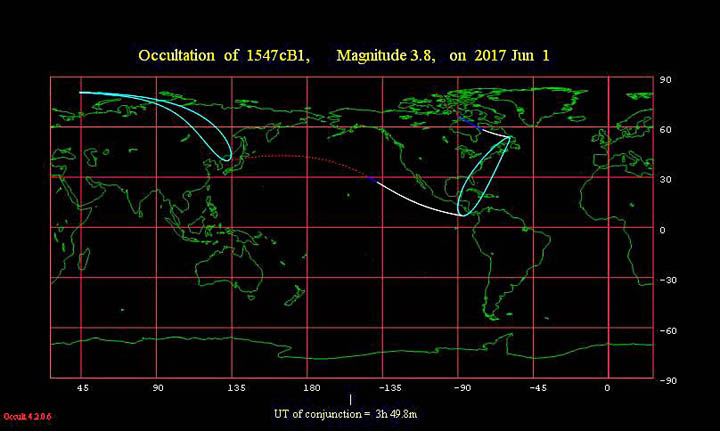
Occult 4.2
Several nights before the conjunction — tonight (May 31st) as a matter of fact — the dark limb of the first quarter Moon will occult the 3.8-magnitude star Rho (ρ) Leonis for much of the United States, Canada, and Mexico. This should be an easy and fun event to see in a small scope, since the relatively bright star will encounter the Moon's dark limb, making for a strong contrast of dark and light. The reappearance on the bright limb approximately an hour later will be more challenging.
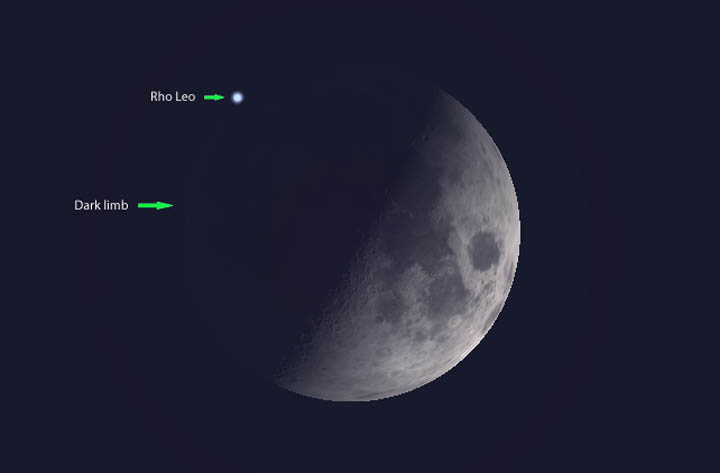
Stellarium
Rho Leonis may look ordinary, but it's one of the "hottest, bluest, most massive stars you can see with the naked eye," according to astronomer James Kaler. The supergiant is roughly 3,650 light-years away with a luminosity 165,000 times that of the Sun and a mass 23 times solar. Rho also keeps a close companion on such a tight 0.01″-long leash that even the largest telescopes can't pry the two apart. Might some variation in light be perceptible as the Moon covers one and then the other star in rapid succession?
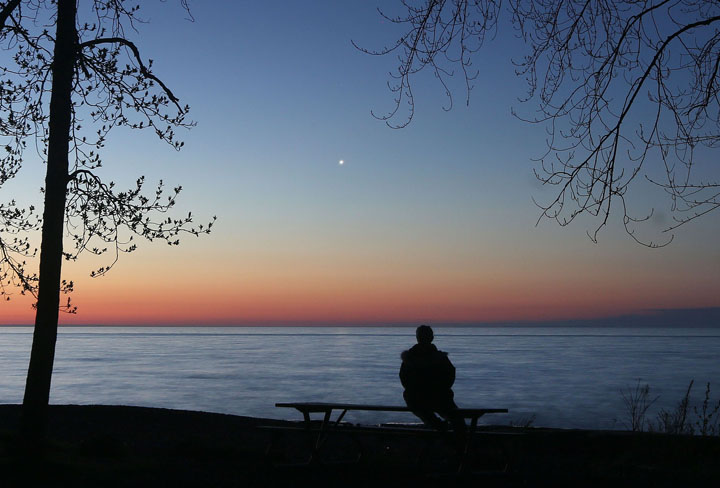
Bob King
From the slick trick of a puny Moon making a massive supergiant vanish to a planetary pairing under the eye of a comet, it's all manna from heaven for the ardent skywatcher.
 10
10









Comments
Anthony Barreiro
June 1, 2017 at 10:20 am
Morning clouds and fog have been obscuring Venus in the morning, but I'll keep looking.
I was able to watch the Earth-lit dark limb of the Moon creep up on Rho Leonis yesterday evening, through mounted 15x70 binoculars. The last few minutes before the occultation were quite suspenseful, and the moment of occultation was surprisingly abrupt -- the star was there one moment and gone the next.
You must be logged in to post a comment.
Bob KingPost Author
June 1, 2017 at 11:30 am
Hi Anthony,
I hope you get clear skies. Thanks for the report on the occultation. I was surprised at how easy it was to see the star in 8x40 binoculars. But I watched it the event itself in my 10-inch Dob. I could just barely detect the dark limb throughout, and the star just zipped away!
You must be logged in to post a comment.
June 6, 2017 at 2:34 pm
Spotted Venus early this morning. Bright summer sky does not make Venus justice here in Sweden. August will bring back the splendor. J
You must be logged in to post a comment.
Graham-Wolf
June 2, 2017 at 8:21 pm
Hi Bob
A great sight down here at 46 South, NZ.
No..... not the occultation, but the comet conjunction.
Venus is rising here ~ 2hr before dawn onset... which here, was 19:08 Ut just the other day.
Bob.. you may recall a report I sent you of an intense Auroral all-nighter about 2 months ago, and the great Southern overflight. Well, no overflight this time, but all night May 28th we had a category 7 on the 9 point index. What an eye opener! IBC 2-3 (mostly the latter) Rays, Curtains etc to ~ 30 deg alt, extending from South - South West. Several awesome pics posted on local websites. Headlined our NZ national news for 2 days solid. Don't you just love living in the Southern Auroral "sweet spot at 46 South? I sure do!!
Graham W. Wolf,
46 South, NZ.
You must be logged in to post a comment.
Bob KingPost Author
June 4, 2017 at 1:14 am
Graham,
We had a great show up here at the same time. Lots and lots of activity. I felt very lucky that the sky cleared up enough to see it. I took a few pix. They're on my blog: http://astrobob.areavoices.com/2017/05/27/geomagnetic-storm-tonight-may-27-28-watch-for-aurora/
You must be logged in to post a comment.
P.Michael-Hutchins
June 3, 2017 at 5:05 pm
I'm pretty sure that I've never heard of "seeing the 8th-magnitude object in binoculars". I have always thought that 6th was the limit.
Of course, it depends on the binocs - and the sky - but the binocs you mention (although not in connection to the comet) are "35-mm or 50-mm binoculars magnifying 7–10×" - and the sky conditions, "Extinction from low altitude".
So what am I missing?
You must be logged in to post a comment.
Bob KingPost Author
June 4, 2017 at 1:12 am
Hi P. Michael,
Many including myself have seen 8th magnitude comets in 50mm binoculars (several this spring, also visible in 40mm binos) provided the sky is reasonably dark. If you live in a large city, 6th would definitely be the limit ... or brighter. Because of low altitude and extinction, I recommended in the article that observers use a 6-inch scope rather than binocular to see the comet.
You must be logged in to post a comment.
Graham-Wolf
June 6, 2017 at 11:20 pm
Thanks for the hypertext link to your other site, Bob.
Nice pics (as usual).
Neptune, Venus and the comet still up there. Too low to see naked eye in a 6.6 sky, even if strellarium quotes Mv 6.2 for the planet. Hey.... try Mauna Kea!!
Now, I have a nasty waxing gibbous Moon about to spoil things, in my pre-dawn skies ~19UT..
-3 to -5 deg C frosts, brrrr, but good clear skies, anyway.
Even managed a quick glimpse at C/2015V2 Johnson near Arcturus the other night, in spite of lunar pollution. Had to put away the 20x80 Polarex Spotterscope and bring out the GOTO 12cm f4 Newt. At 100x, was able to pull it in, with ~Mv3 skies in the FOV. If the Moon spoils, then crank up the aperture. Your 15 incher should be a breeze, Bob.
I fully agree with you, Bob..... Mv 8 comets ARE possible in a 50mm Binoc... I could alkmost get to Mv 10 in 10x70s... but needed a Palomar sky to do it. You'll have to really work for it. A ZLM 6.0 or better sky will help, so will an hour of dark adaptation, Bob. Keep the lights off, when you get up, don't look at any streetlights, stay well behind a light-pollution blocking fence or hedgerow, and just GO FOR IT. Fortune favours the brave! I should also mention the notorious variablity of human visual acuity. As Stephen O'Meara will soon tell you.... öne person's 6.5 sky is another's 5.6 sky". If you don't bother to go outside... heck, don't expect to see anything.
Graham W. Wolf
46 South, NZ.
You must be logged in to post a comment.
SNH
June 8, 2017 at 5:46 pm
Hey Bob,
You mentioned "Will I ever get used to how crazy early summer twilight begins?" on your most recent article. I ran your numbers and found:
For Duluth, MN (46.8°) on the night of June 1st the sun sets at 8:54pm, night begins at 11:35pm and lasts until 2:43am, then the sun rises at 5:17am the next day.
My own numbers look like this:
For Evening Shade, AR (36.1°) on the night of June 1st the sun sets at 8:18pm, night begins at 10:08pm and lasts until 4:09am, then the sun rises at 5:51am the next day.
All this means that I’m getting six hours of darkness as compared to roughly your three hours! I’ll definitely think twice next time before complaining how short my summer nights are.
Scott
You must be logged in to post a comment.
Bob KingPost Author
June 8, 2017 at 8:23 pm
Hi Scott,
Your calculations are correct! Nights are soooo short here in n. Minn. Thanks by the way for your earlier e-mail -- really appreciate it. I'll get back to you on that one.
You must be logged in to post a comment.
You must be logged in to post a comment.